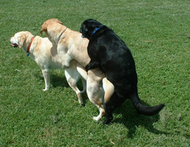Intact Pets: Common Misconceptions
Posted by Julia Ries on 2021 May 27th

Do you have a pet that was neutered or spayed young because you were nervous about them reproducing if they were left intact? Are you aware that female dogs have only small, infrequent windows of when they are able to get pregnant? This article is to shed some light for the public about basic reproduction in our beloved pets, something I believe all pet owners should be aware of, especially those that have puppies, or those soon-to-be pet parents.
I cannot tell you how many times I have heard someone astonished at the fact that we have intact males and females together and the girls are not always pregnant. I once had someone that wanted to breed their golden to my male ask what we meant by “in heat.” If you are not fully aware of what that means either, then you have come to the right place!
Human women ovulate one egg (usually) once every 28 days, give or take a few days, right before we start our menstrual bleeding. We have a lot of opportunities to get pregnant in a year! Dogs and cats, however, are very different. Females can only be bred when they are “in heat.” When a dog is said to be “in heat” this means that they are ovulating, have started bleeding, and have become fertile. They only ovulate once every 5-10 months for about 2 weeks, with multiple eggs at a time. When their heat starts you should notice some droplets of blood coming from their vaginal opening. Be careful not to mistake it for their anus! You may chuckle, but I have seen it happen. The only time a female is fertile is on the 10th-13th days of their proestrus (bleeding), give or take a couple of days. This means that even if you have a female dog with a fast cycle, there are only at most 6-14 days they can become pregnant each year. TOTAL. Female puppies will generally go into their first heat (puberty!) any time between 6 months to 12 months, with male dogs maturing slightly earlier. There are doggy diapers (disposable and reusable ones) that can be used to catch the blood from their heat if you are not wanting to clean up after them. Many females are aware enough to keep themselves clean. As for male dogs, once they hit puberty they are always fertile, but as I said they can only impregnate intact females for a very short window. If you have easy-going males such as us, if your dog does not have hormone-related behavioural problems, or if you do not live with or near any unaltered females, then a responsible owner should have no issues leaving their male intact until the right time. In fact, when our girls are in heat all we have to do is separate them by a door to keep them separate for a week and a half. I hear all the time that people are worried about their males being macho or urinating in the house to mark their territory. Not to say that never is the case, because it certainly does happen, but we have three unneutered males in our house, and they would never pee inside and are all best friends.
You may be wondering why we want everyone to know about how the dog and cat reproductive cycle functions. Obviously, it is more convenient to spay or neuter a dog as young as possible. However, we strongly support letting puppies grow to their full maturity before sterilizing them in order to let their growth plates fuse properly. Doing so will result in healthier bone structure and less chance for joint and ligament injury. We go into detail about the research behind it in our previous article, Spaying and Neutering Young: The Good and the Mostly Bad, if you would like to know more. We are not here to advocate never spaying or neutering, we simply want the general public to understand what is happening in their dog’s bodies, much like it is important to know what happens to your own. Basically, we do not want people’s misconceptions to be the guiding factor on making the important decision on when to spay or neuter their pet. Now, there are several extenuating circumstances where this is not feasible, such as a male that will rip down walls when they smell a female in heat, aggression/dominance stemming from their hormones, or physical deformities/diseases. Every dog and circumstance is different, and everyone has the choice to do what is best in their opinion. It is a major responsibility as a pet owner to be educated in order to make informed decisions.
We hope that this was educational and that maybe you learned a bit about even your own furry friends.

